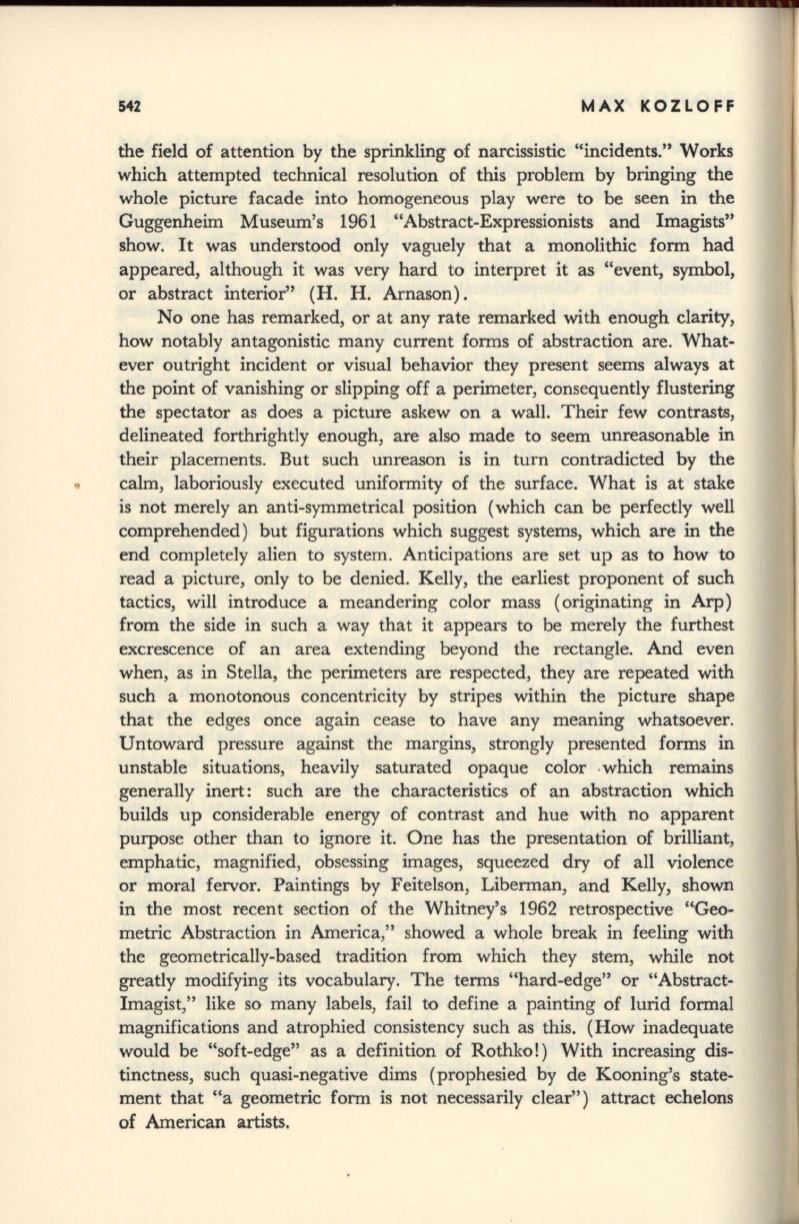

542
MAX KOZLOFF
the field of attention by the sprinkling of narcissistic "incidents." Works
which attempted technical resolution of this problem by bringing the
whole picture facade into homogeneous play were to be seen in the
Guggenheim Museum's 1961 "Abstract-Expressionists and Imagists"
show.
It
was understood only vaguely that a monolithic form had
appeared, although it was very hard to interpret it as "event, symbol,
or abstract interior" (H. H. Arnason).
No one has remarked, or at any rate remarked with enough clarity,
how notably antagonistic many current forms of abstraction are. What–
ever outright incident or visual behavior they present seems always at
the point of vanishing or slipping off a perimeter, consequently flustering
the spectator as does a picture askew on a wall. Their few contrasts,
delineated forthrightly enough, are also made to seem unreasonable in
their placements. But such unreason is in turn contradicted by the
calm, laboriously executed uniformity of the surface. What is at stake
is not merely an anti-symmetrical position (which can be perfectly well
comprehended) but figurations which suggest systems, which are in the
end completely alien to system. Anticipations are set up as to how to
read a picture, only to be denied. Kelly, the earliest proponent of such
tactics, will introduce a meandering color mass (originating in
Arp)
from the side in such a way that it appears to be merely the furthest
excrescence of an area extending beyond the rectangle. And even
when, as in Stella, the perimeters are respected, they are repeated with
such a monotonous concentricity by stripes within the picture shape
that the edges once again cease to have any meaning whatsoever.
Untoward pressure against the margins, strongly presented forms in
unstable situations, heavily saturated opaque color ,which remains
generally inert: such are the characteristics of an abstraction which
builds up considerable energy of contrast and hue with no apparent
purpose other than to ignore it. One has the presentation of brilliant,
emphatic, magnified, obsessing images, squeezed dry of all violence
or moral fervor. Paintings by Feitelson, Liberman, and Kelly, shown
in the most recent section of the Whitney's 1962 retrospective "Geo–
metric Abstraction in America," showed a whole break in feeling with
the geometrically-based tradition from which they stem, while not
greatly modifying its vocabulary. The terms "hard-edge" or "Abstract–
Imagist," like so many labels, fail to define a painting of lurid formal
magnifications and atrophied consistency such as this. (How inadequate
would be "soft-edge" as a definition of Rothko!) With increasing dis–
tinctness, such quasi-negative dims (prophesied by de Kooning's state–
ment that "a geometric form is not necessarily clear") attract echelons
of American artists.









